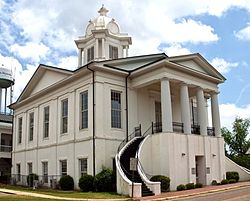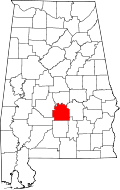From the end of the 19th through the early decades of the 20th centuries, organized white violence increased against blacks, with 16 lynchings recorded in the county, the fourth-highest total in the state, which historically is among those in the South with the highest per capita rate of lynchings. Most victims were black men, subjected to white extra-legal efforts to maintain white supremacy by racial terrorism. [5] Seven of these murders were committed in Letohatchee, an unincorporated community south of Montgomery; five in 1900 and two in 1917. In 1900 mobs killed a black man accused of killing a white man. When local black resident Jim Cross objected, he was killed, too, at his house, followed by his wife, son and daughter. [6] In 1917 two black brothers were killed by a white mob for alleged "insolence" to a white farmer on the road. [7] On July 31, 2016, a historical marker was erected at Letohatchee by the Equal Justice Initiative in coordination with the city to commemorate the people who had suffered these extrajudicial executions. [7]
Civil Rights Era
By 1960 (as shown on census tables below), the population had declined to about 15,000 residents and was about 80 percent-majority black. The rural county was referred to as "Bloody Lowndes", [8] the rusty buckle of Alabama's Black Belt, because of the high rate of white violence against blacks to maintain segregation. In 1965, a century after the American Civil War and decades after whites had disenfranchised blacks via the 1901 state constitution, they maintained white supremacy by intimidation and violence, suppressing black voting. [9]
County population had fallen by more than half from its 1900 high, as both blacks and whites moved to urban areas. Blacks still outnumbered whites by a 4-to-1 ratio. [10] Eighty-six white families owned 90 percent of the land in the county and controlled the government, as whites had since 1901. With an economy based on agriculture, black residents worked mostly in low-level rural jobs. In the civil rights era, not one black resident was registered to vote before March 1, 1965. [11]
When in 1956 NAACP was outlawed in Alabama, local activist John Hulett joined Alabama Christian Movement for Human Rights, a new organization founded by Fred Shuttlesworth. [12] Following passage of the Civil Rights Act of 1964 and the Voting Rights Act of 1965, he joined the voter-registration drive of the Student Nonviolent Coordinating Committee (SNCC), becoming with John C. Larson, a preacher, the first African-Americans on the county's electoral rolls in more than six decades. [13]
With the registration drive "swarmed" by young people, SNCC chairman Stokely Carmichael took the initiative to help form the Lowndes County Freedom Organization (LCFO), with Hulett, its first chair. The first independent black political party in the county since Reconstruction, the LCFO took as its symbol a rampant black panther, representing black "strength and dignity", which contrasted with the white rooster of the segregationist Alabama Democratic Party. [14] (A year later, the example was followed by Bobby Seale and Huey Newton in framing the nationwide the Black Panther Party for Self Defense). The goal was to get enough black people to vote, and to stand as candidates for county office, so that they might be fully represented in local government and redirect services to black residents, 80 percent of whom lived below the poverty line. [15]
The police continued to arrest protesters in the summer of 1965. A group of protesters were released from jail in the county seat of Hayneville on August 20, 1965. As four of them approached a small store, Thomas Coleman, an unpaid special deputy, ordered them away. When he aimed his shotgun at one of the young black women (Ruby Sales), Jonathan Myrick Daniels pushed her down and was shot, which immediately killed him. Coleman also shot Father Richard Morrisroe, a Catholic priest, in the back, then stopped. He was indicted for the murder of Daniels; and an all-white jury quickly acquitted him after his claim of self-defense, although both men were unarmed. Coleman had been appointed as special deputy by the county sheriff. [10] In response to the violence, some LCFO organizers began to openly carry arms. [16]
On May 3, 1966, over 900 registered black voters cast their ballots at the county seat in Hayneville as independent participants in the primary, with some driving over 25 miles to do so. [17] One notable strategy the LCFO encouraged among black voters was to help other black voters if they needed assistance as a precaution against the fact that "the Lowndes County Freedom Organization knew that once a local white person got behind the curtain with a black person, that vote would be lost" (p. 111). [17] Another was to encourage black voters to simply pull the lever to vote strictly for LCFO candidates; in other words, to "pull the lever for the Black Panther and go on home," as stated on a sign on Highway U.S. 80 between Montgomery and Selma. [17]
Whites in Lowndes County reacted strongly against the LCFO. In retaliation for black sharecroppers engaging in civil rights work, white landowners evicted many of them from their rental houses and land plots. They used economic blackmail to make them both homeless and unemployed in a struggling economy. The SNCC and Lowndes County leaders worked to help these families stay together and remain in the county. They bought tents, cots, heaters, food, and water and helped several families build a temporary "tent city". Despite harassment, including shots regularly fired into the encampment, these black residents persevered for nearly two years as organizers helped them find new jobs and look for permanent housing. [18]
Whites refused to serve known LCFO members in stores and restaurants. Several small riots broke out over the issue. The LCFO pushed forward and continued to organize and register voters. [14] However, none of their candidates won in the November 1966 general election. In a December 1966 edition of The Liberator, a Black Power magazine, activist Gwendolyn Patton alleged the election had been subverted by widespread ballot fraud. [19] But historians believe that black sharecroppers refrained from voting, submitting to the severe pressure put on them by the local white plantation owners, who employed most of them. [20] After the LCFO folded into the statewide Democratic Party in 1970, African Americans have supported candidates who have won election to local offices. [20] In a continuing divide, since the late 20th century, most white conservative voters in Alabama have shifted to the Republican Party.
In White v. Crook (1966), Federal District Judge Frank M. Johnson ruled in a class action suit brought on behalf of black residents of Lowndes County, who demonstrated they had been excluded from juries. Women of all races were excluded from juries by state statute. Johnson ordered that the state of Alabama must take action to recruit both male and female blacks to serve on juries, as well as other women, according to their rights under the Fourteenth Amendment. The suit was joined by other class members from other counties who dealt with similar conditions of exclusion from juries. It was "one of the first civil actions brought to remedy systematic exclusion of Negroes from jury service generally." [21]
The LCFO continued to fight for wider political participation. Their goal of democratic, community control of politics spread into the wider civil rights movement. After merging with the state Democratic Party in 1970, LCFO candidates began winning public offices, Hulett becoming the first black sheriff in the county to be elected since Reconstruction. [22]
Today an Interpretive Center in the county, maintained by the National Park Service, memorializes the Tent City and LCFO efforts in political organizing. [18]
The "DEI" sewage controversy
In April 2025, the U.S. Justice Department terminated a landmark civil rights settlement with the State of Alabama to address serious health risks posed by the county's inadequate sanitation systems. The department claimed that the Biden-era agreement violated President Donald Trump’s proscription of DEI (diversity, equity and inclusion) initiatives. [23] [24]
The Alabama Department of Public Health said that it would continue working on remedial actions envisaged by the 2023 settlement "until appropriated funding expires”. [23]




